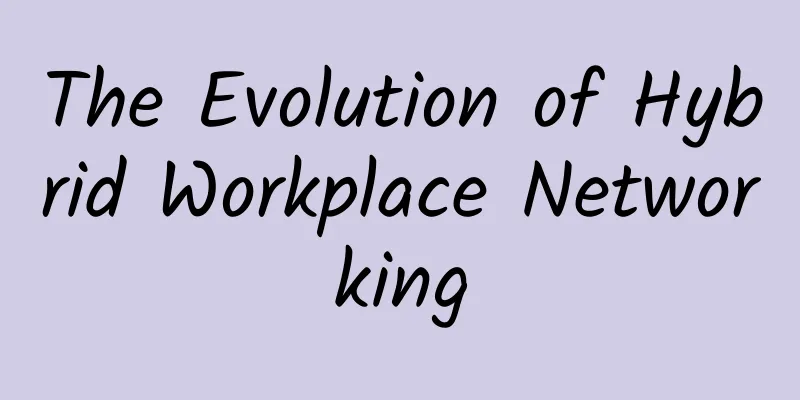The Evolution of Hybrid Workplace Networking

|
The past few months have significantly changed the digital transformation journey of most organizations, especially strategies around business continuity and digitalization, as well as ensuring the productivity of a remote and distributed workforce. As organizations evolve, the ability to deliver high-quality, digital-first experiences to employees, customers, and partners will become a cornerstone of digital investment, in addition to continuity and resiliency. This is increasingly becoming a critical requirement; in a recent survey, only 46% of CEOs and COOs believed their organizations were good at delivering high-quality user experiences across the value chain. Going a step further, many global organizations now recognize the need to transform their traditional networks, which have been operating on a hub-and-spoke model, to cater to emerging dynamic business needs. Nearly half of the survey respondents said their company’s productivity declined during the crisis due to connectivity issues.
Here are some common areas that businesses may face in the transition to the new hybrid world and providing quality digital experiences to employees and customers. Transitioning to Cloud-First and Internet-FirstTraditional enterprise network architectures were neither designed for the cloud nor to facilitate digital transformation (IDC, 2020) In a hybrid workplace, organizations want to drive seamless, consistent collaboration internally and with customers in a secure manner across the globe. A key enabler to achieve this goal is to adopt a cloud-first and internet-first strategy. By taking this step, they are moving away from distributed architectures and hub-and-spoke enterprise-wide networks. As a result, their reliance on traditional enterprise networks and fixed designs is no longer a hindrance to operations. However, moving to the cloud and using the Internet presents two major challenges:
Organizations need to ensure they can provide secure and seamless remote access to core enterprise applications over untrusted networks and strike the right balance between ensuring security and not making access too difficult. Managing multiple Internet service providers and navigating different geographic regulations around the world also adds complexity, which can quickly become a major overhead for a globally distributed workforce. Embed more intelligenceBy the end of 2024, 75% of enterprises will have moved from piloting to implementing AI, driving a 5x increase in streaming data and analytics infrastructure (Gartner, 2020) This new architecture for hybrid working environments will not only need to be agile, scalable, and flexible, but it will also require the adoption of AI and ML, for example, using AI to help with capacity planning and managing networks in a more dynamic and agile way. Artificial intelligence and machine learning, along with the associated data analytics, will help streamline service and network management. Companies using ML can predict and proactively manage networks by looking at data and trends to quickly take preventive action. These will be key industry trends that will continue to evolve as we move into 2022. Optimize and build new hybrid networks to increase efficiency and productivityThe pandemic has led to a realignment of cloud strategies, with collaboration, mobility, and virtual desktops rapidly migrating to the cloud to support a distributed and secure workforce (Gartner, 2021) This new network architecture that embraces the Internet, the cloud, and intelligence will need to support new digital business models and new hybrid work environments. Solutions will not only need to reduce costs, but also provide consistent user performance, unified service level agreements (SLAs), and complete visibility. An example of a use case is a global bank that wants to achieve superior site-to-site communications and accelerate cloud adoption. To achieve this, they need to adopt a strategy that provides internet connectivity to all of their different branch offices in India from a public cloud provider. This will help it not only reduce costs but also optimize performance. Similarly, a pharmaceutical company may be migrating its global network from Multiprotocol Label Switching (MPLS) to a hybrid environment - combining MPLS and the internet will help achieve cost savings and provide a "single pane of glass" that provides more visibility and control over all networks. In each of these scenarios, these enterprises can save money and gain the flexible network that is necessary for an efficient hybrid workplace. Building an Agile Network ArchitectureBy 2022, 67% of organizations will adopt SD-WAN (IDC, 2020) In a hybrid world, it’s key to find the right balance of connectivity between office and remote workers. To do this, you need to check:
To address this, you need an agnostic network that can be deployed quickly to meet dynamic business needs. Software-defined networking (SD-WAN) is part of the solution; for example, new sites can be provisioned remotely. On-demand solutions are also needed, especially for connectivity to major data centers and cloud providers. The silver bullet is essentially the ability to choose the type of connectivity capacity you need by time, by day, and for how long you need it - all under the customer's control. Protect your business from the new risks exposed in this new paradigmCorporate, guest, trusted and untrusted devices all pose risks to the enterprise if I&O leaders don’t properly coordinate when and how they connect. (Gartner, 2021) Security is key to enabling a hybrid workplace, moving from a perimeter-based security model with IP addresses and locations to an adaptive access policy approach using integrated identity endpoint management and security tools. This approach allows enterprises to assess risk based on user identity and device trust. It is about enabling continuous and complete risk assessment of endpoints or unified endpoint management. Finally, true agility will be on-demand networking; dynamically moving connections up and down with guaranteed SLAs. Using AI and machine learning, this provisioning can be automated - both activating and de-activating capacity can be done without human intervention. In short, the intranet and the extranet are no longer two separate worlds. Enterprises need a comprehensive policy for both, which means they can start to deploy new technologies and reap the rewards. It's time to create a truly dynamic network for an unpredictable hybrid world. |
<<: The End of 2G and 3G Networks: The Transition to 4G and Beyond
>>: Mexico City has the most free WiFi access points: Guinness World Record
Recommend
Local area communication technology is moving towards wide area communication technology, accelerating the arrival of the era of whole-house intelligence
[[399909]] Smart home has a long history. In the ...
5G brings more than just internet speed. What does 5G really mean?
What does 5G mean? It means faster upload and dow...
Hengchuang Technology Double Eleven: Hong Kong/US cloud server annual payment starts from 198 yuan, popular server 25% off
Hengchuang Technology is a long-established domes...
Megalayer Summer Promotion: US servers start from 99 yuan/month, Hong Kong high-defense servers start from 299 yuan/month
Megalayer launched a summer ice point special off...
CMIVPS: US VPS monthly payment 60% off, annual payment 50% off, Seattle high-security AS4837 line optimization starting from $4/month
This month, CMIVPS is offering a limited special ...
COVID accelerates interest in 5G, digital transformation, and IoT
[[409518]] The COVID-19 pandemic has accelerated ...
BandwagonHost: $99/year - 2GB/40GB/1TB/17 data centers in Hong Kong & Japan, 1-2.5Gbps bandwidth CN2 GIA line
BandwagonHost has launched a special package, a d...
10 excellent log analysis tools that network administrators must have
If network administrators want to master network ...
The principle of Ethernet data transmission is like this, it is worth collecting
First, let's review the basic concept of rout...
Twisted Pair vs. Fiber Optic Cable Advantages and Challenges
Data transmission is the backbone of today's ...
Bluetooth, WiFi and ZigBee: Which of these three wireless transmission technologies will dominate the world?
[[277331]] There are more and more smart products...
SAP HANA Express Edition for Developers Launched on Huawei Cloud
On September 5, during HUAWEI CONNECT 2017, Huawe...
Yecao Cloud's New Year's Big Offer: Hong Kong VPS annual payment starts from 138 yuan, Hong Kong dedicated server starts from 299 yuan/month
Yecaoyun has announced a huge discount event for ...
Interviewer: What are the underlying data types of Redis? Why is Redis so fast? Why did Redis introduce multithreading? What is the implementation mechanism of Redis multithreading?
Interview question overview: What are the underly...
With spending of the three major operators declining, has China's 5G construction slowed down?
In 2020, China's 5G network construction deve...









